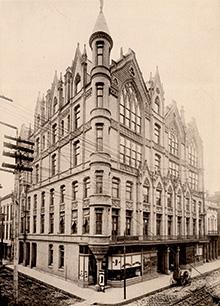Medieval revival
The façade of an old Masonic Temple (pictured here) is a “cross between a medieval castle and a cathedral,” writes Tulane University geographer Richard Campanella in his book Lost New Orleans. Completed in 1892 — and demolished in 1922 — the building is an example of the medieval revival style, popular in Louisiana architecture during the mid- to late 1800s.
To highlight the medieval revival period — and the architects who referenced medieval culture for their Louisiana clients — an exhibit, “Medieval Louisiana,” is on display through May 20 at the Southeastern Architectural Archive in room 300 of Jones Hall on the Tulane uptown campus.
The influence of the medieval revival style is evident throughout Louisiana architecture of that era in the design of residences, businesses and religious structures.
“Like much of the country, this region adopted many different historic revival styles in the late 19th and early 20th centuries,” says Keli Rylance, head of Southeastern Architectural Archive. “The medieval styles that were part of the mix include Byzantine, Moresque, Romanesque and Gothic.”
This Masonic temple, sharing a resemblance with several New Orleans churches, was designed by architect James Freret and located at 333 St. Charles Ave., at the corner of Perdido Street.
Its roof contained several peaks consistent with medieval style, large Gothic windows and a five-story corner turret. It had intricate friezes and tracery, as well as trefoil and quatrefoil ornamental designs. These features distinguish Gothic revival structures around New Orleans today.
The upper floors contained meeting rooms, libraries, the grand lodge and office space for businesses to rent. The commercial space on the ground floor provided rental income for use in the upkeep of the high-maintenance structure.
After 30 years, the fraternal organization demolished the structure, replacing it with a new, more modern Masonic lodge, which today houses a bustling Hilton hotel. The corner retail space is now home to chef John Besh’s Lüke restaurant.
Rylance and archivist Kevin Williams are co-curators of the exhibit, which is open 9 a.m.–5 p.m., Monday–Friday. Admission is free. Call 504-865-5699 for more information.

